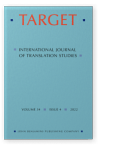Vol. 34:4 (2022) ► pp.602–627
Time pressure in translation
Psychological and physiological measures
Translators may experience significant psychological and physiological responses to time pressure. This study examines such responses with the aim of identifying valid indicators of time pressure in written translation. Forty-five postgraduates participated in the study, translating three comparable English texts into Chinese under three time conditions (Short, Standard, and Free). A positive relation between time stringency and the arousal level detected by a set of self-reporting and biomarker measures was hypothesised. The hypothesis was corroborated by results derived from participants’ self-reporting on stress and anxiety, and the biomarkers of heart rate, blood pressure, and pupil dilation, but not by skin temperature, galvanic skin response (GSR), and heart rate variability (HRV). Thus, the measures that confirm the hypothesis are considered successful indicators of time pressure in translation. In addition, an inverted ‘U-shaped’ pattern was observed in the relation between time stringency and the arousal level indexed by GSR and HRV. These findings may facilitate research and training in translation and other cognitively demanding language-processing activities.
Article outline
- 1.Introduction
- 1.1Methodological considerations
- 1.2Existing translation and interpreting research on time pressure or stress
- 1.3The present study
- 2.Method
- 2.1Participants
- 2.2Materials
- 2.3Time constraints
- 2.4Apparatus
- 2.5Procedure
- 2.6Data processing and analysis
- 3.Results
- 3.1Psychological measures
- 3.2Physiological measures
- 3.3Correlations among the psychological and physiological measures
- 3.4Results from the trimmed dataset
- 4.Discussion
- 4.1Psychological effects
- 4.2Physiological effects
- 5.Conclusions
- Notes
-
References
